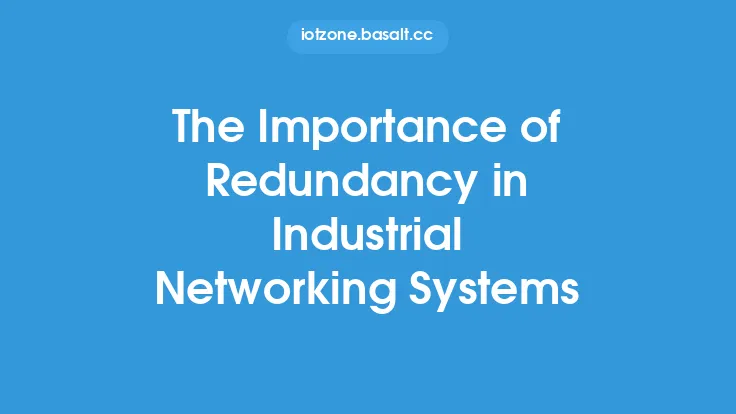The increasing demand for interconnected devices and data-driven decision-making has led to the rapid growth of the Industrial Internet of Things (IIoT). At the heart of this ecosystem lies industrial networking, which plays a crucial role in enabling the seamless communication and data exchange between devices, systems, and applications. Industrial networking is the backbone of IIoT infrastructure, providing the necessary connectivity, reliability, and security for industrial devices and systems to operate efficiently.
Introduction to Industrial Networking
Industrial networking refers to the use of networking technologies and protocols to connect and communicate between industrial devices, such as sensors, actuators, controllers, and other equipment. These networks are designed to operate in harsh environments, such as manufacturing plants, oil and gas refineries, and other industrial settings, where reliability, security, and low latency are critical. Industrial networks are used to monitor and control industrial processes, collect data, and enable real-time decision-making. They are also used to integrate different systems and devices, such as supervisory control and data acquisition (SCADA) systems, programmable logic controllers (PLCs), and remote terminal units (RTUs).
Key Components of Industrial Networking
Industrial networking consists of several key components, including devices, protocols, and infrastructure. Devices such as sensors, actuators, and controllers are connected to the network using various protocols, such as Ethernet, Wi-Fi, or wireless mesh networks. These protocols provide the necessary connectivity and communication between devices, allowing them to exchange data and control signals. The infrastructure of an industrial network includes switches, routers, and other networking equipment that provide the necessary connectivity and bandwidth for devices to communicate.
Industrial Networking Protocols
Industrial networking protocols are designed to provide reliable, secure, and efficient communication between devices. Some common industrial networking protocols include EtherNet/IP, Profinet, and Modbus TCP. These protocols are used to enable device-to-device communication, as well as device-to-cloud communication, allowing for real-time monitoring and control of industrial processes. Other protocols, such as OPC-UA and MQTT, are used for data exchange and integration between different systems and devices.
Network Topologies and Architectures
Industrial networks can be designed using various topologies and architectures, depending on the specific requirements of the application. Common network topologies include star, ring, and mesh topologies, each with its own advantages and disadvantages. Network architectures, such as client-server and peer-to-peer architectures, are also used to design industrial networks. The choice of network topology and architecture depends on factors such as the number of devices, the type of application, and the required level of reliability and security.
Security Considerations
Security is a critical aspect of industrial networking, as industrial networks are often targets for cyber attacks. Industrial networks require robust security measures to prevent unauthorized access, data breaches, and other security threats. Common security measures include firewalls, intrusion detection systems, and encryption technologies. Network segmentation, access control, and authentication are also used to restrict access to authorized personnel and devices.
Real-Time Communication and Low Latency
Industrial networks require real-time communication and low latency to enable efficient and reliable operation of industrial processes. Real-time communication is critical in applications such as control systems, where delays can have significant consequences. Low latency is also essential in applications such as video surveillance, where real-time video streaming is required. Industrial networking protocols and technologies, such as Ethernet and Wi-Fi, are designed to provide low latency and real-time communication, enabling efficient and reliable operation of industrial processes.
Integration with Other Systems and Technologies
Industrial networking is often integrated with other systems and technologies, such as SCADA systems, PLCs, and RTUs. This integration enables real-time monitoring and control of industrial processes, as well as data exchange and integration between different systems and devices. Industrial networking is also integrated with other technologies, such as cloud computing, big data analytics, and artificial intelligence, to enable advanced applications such as predictive maintenance, quality control, and supply chain optimization.
Future Trends and Developments
The future of industrial networking is expected to be shaped by emerging trends and technologies, such as 5G wireless networks, edge computing, and artificial intelligence. 5G wireless networks are expected to provide high-speed, low-latency communication, enabling advanced applications such as real-time video streaming and remote control. Edge computing is expected to enable real-time data processing and analysis, reducing latency and improving overall system efficiency. Artificial intelligence is expected to enable advanced applications such as predictive maintenance, quality control, and supply chain optimization, improving overall system efficiency and productivity.
Conclusion
In conclusion, industrial networking plays a critical role in enabling the seamless communication and data exchange between devices, systems, and applications in IIoT infrastructure. The key components of industrial networking, including devices, protocols, and infrastructure, work together to provide reliable, secure, and efficient communication between devices. Industrial networking protocols, network topologies, and architectures are designed to meet the specific requirements of industrial applications, providing real-time communication, low latency, and robust security. As the IIoT continues to evolve, industrial networking is expected to play an increasingly important role in enabling advanced applications and improving overall system efficiency and productivity.




